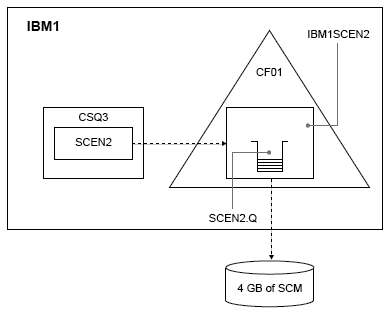Adding SCM to the initial structure
How you add SCM for improved performance on IBM MQ .
About this task
This part of the task uses the basic configuration described in Improved performance - basic configuration. The scenario describes the addition of SCM to the initial structure.
This final configuration is illustrated in Figure 1.
Procedure
-
Add 4 GB of SCM to structure IBM1SCEN2 by carrying out the following
procedure:
-
Check how much SCM is installed, and allocated to CF01, by issuing the
following command:
D CF,CFNAME=CF01
- Check the STORAGE-CLASS MEMORY figures in the STORAGE CONFIGURATION section of the displayed output to see the available storage.
-
Update the CFRM policy with the SCMMAXSIZE and SCMALGORITHM
keywords as shown:
STRUCTURE NAME(IBM1SCEN2) SIZE(2048M) INITSIZE(2048M) ALLOWAUTOALT(YES) FULLTHRESHOLD(85) PREFLIST(CF01) ALLOWREALLOCATE(YES) DUPLEX(DISABLED) ENFORCEORDER(NO) SCMMAXSIZE(4G) SCMALGORITHM(KEYPRIORITY1)
-
Check how much SCM is installed, and allocated to CF01, by issuing the
following command:
-
Activate the CFRM policy by issuing the following command:
SETXCF START,POLICY,TYPE=CFRM,POLNAME=IBM1SCEN2
-
Rebuild the IBM1SCEN2 structure.
We must carry out this procedure because the structure was allocated when you made the
previous changes. Issue the following command to rebuild the structure:
SETXCF START,REBUILD,STRNM=IBM1SCEN2
-
Issue the following command to confirm the new configuration of the structure:
D XCF,STR,STRNAME=IBM1SCEN2
Review the output of the command, a portion of which follows:SPACE USAGE IN-USE TOTAL % ENTRIES: 33 342684 0 ELEMENTS: 48 6503697 0 EMCS: 2 575600 0 LOCKS: 1024
Results
Calculate the change in the use of real storage by the increase in control storage required to use SCM.- Before SCM is added to the structure, the structure has these totals as shown in Improved performance - basic configuration:
- 345,242 entries
- 6,548,467 elements
- 780,318 EMCS
- After SCM is added to the structure, the structure has these totals:
- 342,684 entries
- 6,503,697 elements
- 575,600 EMCS
Using these figures, after the SCM was added, the structure is reduced in size by:
- 2558 entries
- 44,770 elements
- 204,718 EMCS
The amount of structure storage that is used to manage SCM, is as follows for a 2 GB structure with 4 GB of SCM allocated:
(2558 + 44,770 + 204,718) * 256 = 61.5 MB
Note that adding more SCM is likely to achieve only a marginal reduction of the size of the structure, because the amount of control storage used to track SCM increases, both as the structure size, and the amount of allocated SCM increases.
What to do next
Repeat the tests described in the final section of Improved performance - basic configuration.
We can plot the results of the revised application over a period of time. Comparing the plot to the one obtained previously, you now obtain an output without a saw-tooth wave, as the putting application no longer has to wait for the queue to partially empty.
For more information, refer to MP16: WebSphere MQ for z/OS - Capacity planning & tuning.
Parent topic: Improved performance - basic configuration